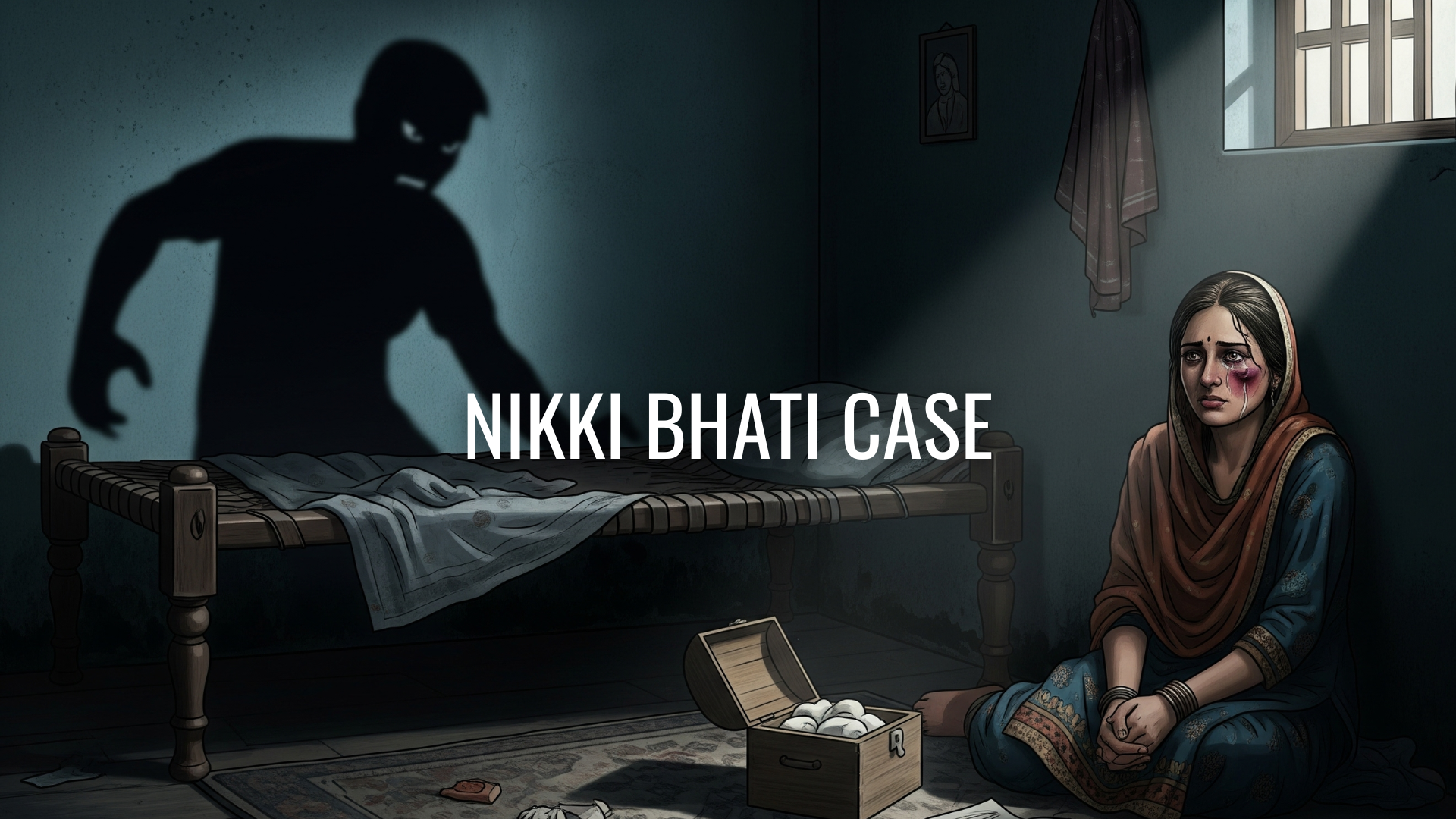Disclaimer
This article discusses real-life cases of domestic violence, abuse, and other sensitive social issues. It is intended for informational and educational purposes only. Some descriptions may be distressing or triggering to readers. The content reflects the author’s perspective and analysis, and is not legal, medical, or professional advice. Reader discretion is strongly advised.
Nikki Bhati Case — The news of Nikki’s death in Noida shook people across the country. It wasn’t just another headline; it opened up the painful reality of violence inside marriages. Her husband, Vipin Bhati, accused of killing her, was shot dead in a police encounter. The search ended there. But the story didn’t start that day. Nikki’s father said there had been dowry harassment and physical abuse for a long time. This wasn’t sudden; it was a slow burn that ended in tragedy.
The day she died, the argument at home turned fatal. Police investigation followed, and the media covered every detail. But behind the updates, this is a story about a system where such things keep happening. And this isn’t just about Nikki; it’s about what marriage can become when control, money, and ego take center stage.
Her family had tried to bring her back home before, but like so many others, they faced the weight of “what people will say.” That silence can kill. And Nikki’s story is one of many.
Look beyond one case, and you see the pattern. In Jalpaiguri, a man suspected his wife of having an affair. He killed her and then walked around with her heart in his hand. In Hyderabad, a pregnant woman was chopped into pieces by her husband after repeated fights. Her body parts were thrown into a river. In Ghaziabad, a young woman died after months of dowry harassment and assault. Her husband and in-laws are now behind bars.
These stories are different in detail but share the same root: violence inside relationships, turning homes into battlefields.
And it’s not just men killing women. In Baghpat, a woman and her lover murdered her husband. They were sentenced to life because their 12-year-old son testified against them. In Vijayawada, another woman pushed her lover to “remove the obstacle”—her husband. These cases show one thing: when trust breaks down and anger takes over, marriages can turn into something brutal, no matter which side it starts from.
Money adds another layer to the conflict. In Haridwar, a man killed his ex-wife to avoid paying alimony. Across the ocean, in the US, a man did the same, murdered his ex-wife to keep his money and property. The pattern repeats because when financial pressure mixes with fragile egos, violence often follows.
The numbers make this even clearer. NCRB data says domestic violence is the most common crime against women in India. In 2023, NCW got over 28,000 complaints of crimes against women. Half came from one state, Uttar Pradesh. And it doesn’t always end in murder. Many end in suicide. Government reports say marital issues and affairs are among the top reasons people take their lives.
These cases, from Nikki to countless unnamed victims, tell us something we don’t like to admit. The danger isn’t outside our homes. It’s often inside. We grow up believing marriage is safety, partnership, and love. But for many, it becomes a trap filled with control, pressure, and fear.
And the hardest question remains: How do we stop this? Because laws alone aren’t fixing it. Police cases aren’t fixing it. Every time there’s outrage, new guidelines come, more arrests happen, but the cycle never ends. Why? Maybe because we are not looking deep enough. This isn’t just about crime; it’s about the framework we live inside. The culture, the expectations, the roles we are told to play—they all meet at one point: marriage.
These problems are not new. They’ve been walking with us for generations. Many people have tried to fix them through laws, social campaigns, awareness drives, but nothing really changes. The question is, why? If we have to truly understand this whole thing, we can’t just look at the symptoms; we have to look at the root cause. And that root, whether we like to admit it or not, is marriage.
So let us take a closer look at marriage.
A Brief History of Marriage
If we’re really looking at the root, we have to ask: where did marriage even begin? It’s strange to think about because today, we see it as an emotional bond, a divine holy bond especially in India, a choice made out of love. But that’s not how it started—not even close.
Early humans didn’t have priests or ceremonies. According to anthropologists like Edvard Westermarck, whose work The History of Human Marriage is often cited (source), the first form of marriage was basically about survival. Pairing up helped people share food, raise children, and keep the group organized. Love wasn’t the center of it; survival was.
Then farming came along, and everything changed. Land and property became important. Suddenly, marriage wasn’t just about living together—it was about keeping wealth in the family. The Wikipedia page on Marriage notes that alliances through marriage shaped entire communities and sometimes even whole kingdoms. Two people getting married could mean peace between rival clans or an increase in social power.
Religion entered later and gave marriage a sacred tag. It was now not just a social contract but something holy. But even with all the rituals and blessings, love still wasn’t the main reason people married. Historian Stephanie Coontz explains this clearly in her book Marriage, a History (source): for thousands of years, marriage was more about duty, economics, and status than about feelings.
Women had it especially hard. In many legal systems, a woman’s identity was literally absorbed into her husband’s after marriage. This was called “coverture,” which meant she couldn’t own property or sign contracts. The International Museum of Women describes how long it took for these laws to change and give women basic rights within marriage.
So, when did love enter the picture? Much later. With industrialization and the rise of individual freedom, marriage slowly shifted from being an economic strategy to something more personal. People began to expect companionship and emotional support. The article “The Evolution of Marriage Over Time” explains this journey—from survival to strategy to intimacy. And today, in the 21st century, marriage is almost unrecognizable compared to its early forms. Sociologist Andrew Cherlin even says it’s becoming “deinstitutionalized” (source), meaning the rules around it are breaking down. People now choose whether they want marriage at all, or they live together without it. However, in India, even today, about 90% of marriages are still arranged by families.
But even with all these changes, old ideas linger—power, money, and gender roles still shape marriage. Dowry, child marriage, domestic violence, and fights over alimony aren’t random; they come from what marriage was built on: control, property, and social expectation. Marriage was never just about two people; it’s a system. And when that system fails, the damage hits homes, families, and lives.
So, let us take a closer look at the socio-economic problems related to marriage.
Socio-Economic Evils of Marriage
If marriage was meant to be a safe space, reality often looks different. Some of its biggest problems are not accidental—they come from the same roots we just spoke about: power, money, and control. And these problems don’t just affect one family; they shape society. Let’s look at a few of them.
Dowry and Domestic Violence
Dowry started as a way for parents to give gifts to their daughter when she left home. But over time, it turned into something else—a demand. A price tag on marriage. Studies show how dowry has shifted from a social custom to a commercial transaction that often ends in harassment or even death (source).
Even though India has laws against dowry, it’s still widespread. A journal article in the Journal of Biosocial Science points out that dowry harassment is common in both rural and urban India, and it connects deeply with how women are seen as subordinate in the family.
And when demands aren’t met, violence follows. The law calls it “dowry death,” but that’s a soft phrase for something brutal—women being tortured, burned, or killed. Despite anti-dowry laws, weak enforcement, and societal silence keep this evil alive.
Child Marriage
We often think of child marriage as an old custom that’s gone, but it’s still here; just hidden in places we don’t always see. According to UNICEF, India has made progress, but millions of child brides still exist, and almost half of them live in just these five states: Uttar Pradesh, Bihar, Maharashtra, West Bengal, and Madhya Pradesh.
Why is it dangerous? Because a child bride doesn’t just lose her childhood; she also faces higher risks of abuse and violence. A comparative study across 34 countries found that child marriage strongly links to intimate partner violence. Poverty, lack of education, and patriarchal control push families into this, violating basic human rights.
Patriarchy and Coverture
Marriage, in many ways, was designed for control, and patriarchy made sure women stayed under it. One clear example is the old British legal idea of coverture: when a woman married, her legal identity merged into her husband’s. She couldn’t own property, sign contracts, or act independently.
You’d think that’s ancient history, but traces of this still shape Indian personal laws today. A research article argues that the mindset behind coverture continues to affect intermarried women in India. Add to that a cultural bias that sees girls as a burden and their sexuality as family “honor,” and you understand why early marriage and control over women persist.
Alimony and Divorce
Divorce is supposed to be the way out of a broken marriage, but it comes with its own set of battles. Alimony, meant to support the financially weaker spouse, often turns into a legal tug-of-war. Sometimes it’s a lifeline; other times, it becomes a tool for harassment and extortion. Recent rulings by the Supreme Court have tried to bring clarity, but the debate continues (source).
The rules vary by religion and situation—permanent, temporary, or rehabilitative maintenance, but the fight over money rarely stays clean. And when combined with ego, property disputes, and sometimes even violence, it shows that ending a marriage can be as complicated as staying in one.
These issues show how marriage is tangled with power and society, but its impact runs deeper into the human mind. How does this bond shape us emotionally? What happens when it turns toxic, especially for children growing up in such homes? And beyond all that, the big question: are humans really made for this idea of marriage, or is it something culture forced on nature? Let’s explore these psychological layers next.
The Psychological Weight of Marriage
The psychological weight of marriage is something we rarely talk about. Beyond the ceremonies and promises, it often becomes a breeding ground for stress, anxiety, and emotional scars. What’s supposed to bring comfort can quietly turn into a mental battlefield, and the damage isn’t always visible, but it’s real.
Think about it. Couples fight, they argue, and money, roles, and expectations make it worse. And in a lot of Indian homes, marriage is rarely just about the couple; it’s about social status, family honor, keeping everyone happy. So arguments that might seem small elsewhere blow up here. Over time, all that pressure creates mental fatigue, anxiety, even depression. And it’s not just about small fights. These are slow burns that eat away at people’s well-being.
For women, it’s even harsher. Suddenly, freedom disappears. Your dreams, your choices, even your identity quietly vanish. The household expects you to cook, clean, care for everyone, and maintain family pride. Over time, performing these repetitive, never-ending tasks turns people into machines. And research shows this isn’t just exhausting; it damages mental health, creates depression, and leaves women questioning who they really are. It’s strange to think that a bond meant for support can end up crushing the very person it’s supposed to protect.
And then there’s the joint family. Sometimes it helps, sometimes it suffocates. Lack of privacy, constant judgment from elders, and hierarchy create silent stress. Women in particular live under unspoken rules: adapt, obey, adjust. No wonder so many report feeling trapped or anxious.
And the kids. We rarely think about them, but they notice everything. Every argument, every bit of tension, every act of violence, they carry it all. Children growing up in these homes are often anxious, aggressive, or distrustful. They learn that conflict is normal, love is complicated, and safety is fragile. That’s before we even add domestic violence into the mix—then their world becomes a cycle of fear, confusion, and pain.
Marriage doesn’t just impact individuals; it shapes minds. It shapes the way women think about themselves, the way children grow up, the way people handle love and conflict. And here’s the kicker: maybe it’s also fighting against our own nature. Early humans weren’t strictly monogamous; they had flexible mating strategies. Some formed strong pair bonds, others didn’t. What we think of as lifelong, exclusive marriage came later, reinforced by property, inheritance, and social system.
You May like
What Is Love, Really? A Deep Dive into Sternberg’s Triangular Theory of Love
So if nature didn’t exactly design us for lifelong marriage, could it be that forcing ourselves into this mold is why infidelity, dissatisfaction, and divorces are so common today? Maybe the problem isn’t just some people, but also the faults in the institution itself. And that’s a hard truth to swallow, because we’ve been told marriage is the goal, the safest place, the ideal. But when reality doesn’t match that story, stress, tension, and psychological scars appear.
Finally…
Finally, we come to the big question. After everything — dowry, violence, control, gender roles, broken homes — maybe we need to ask: Is marriage even the right system for us? Or is it something we created for survival thousands of years ago and never stopped to question? Back then, pairing up made sense; it gave security, food, and order. But today? Are we forcing an old design onto a new world just because it feels safe?
And if it doesn’t fit perfectly, what then? Do we change marriage? Do we change ourselves to keep it alive? Or do we dare to imagine something better, something that fits the way we live, love, and think now? These aren’t easy questions, but they matter. Because whether marriage is natural or cultural, whether humans are monogamous or not, the truth is, the system alone won’t save us.
The answer, as hard as it sounds, comes back to the individual. Society is not some giant machine standing apart from us, it is us. Every law, every custom, every norm was created by individuals and is carried forward by individuals. So if we want a different society, the change has to begin where it all starts, inside a single person.
We can change rules, run campaigns, add stricter laws, but those are bandages on a wound that keeps bleeding. They work for a while, then the old patterns return. Why? Because the root hasn’t changed, the mind that created those patterns is still the same. Unless there’s an inner revolution, unless people look at their own egos, their anger, their obsession with control, nothing truly changes.
Gandhi said it best: “Be the change that you wish to see in the world.” And that isn’t a fancy slogan, it’s a survival strategy. As long as we avoid this, as long as we expect solutions to come from the outside, cases like Nikki Bhati’s will keep flashing on our screens. Every time, we will ask, “How could this happen?” But the truth is, it happens because we haven’t changed.
Until then, everything else, laws, debates, policies, will remain temporary solutions, painting over a cracked wall. The real work is harder but simpler: individuals taking responsibility, questioning themselves, and changing at the core. That’s the only way to build something real.







